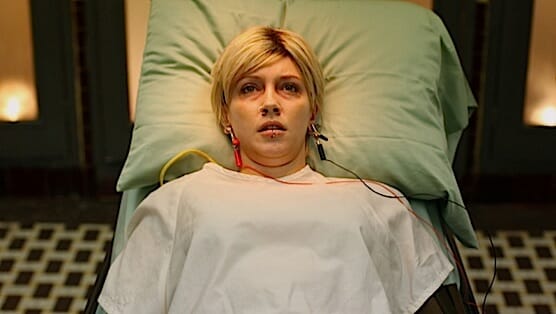The Scribbler

The Scribbler is overwrought, absurd, occasionally exploitative, completely lacking in subplot, takes a good 20-25 minutes to really get going and has acting that varies from excellent to, well, less-than-excellent. It’s also hugely fun! It’s bonkers, sure, but in a good way. It’s a dark and suspenseful sci-fi yarn with a compelling, female-driven story. It’s visually interesting and actually has some nice twists and turns. And of course there’s a talking bulldog with a cockney accent.
As an ardent fan of science fiction and what the unenlightened often dismissively refer to as “comic book movies,” I have set rather a high bar. I have no time for derivative or amateurish stories, for films that needlessly violate long-held principles of the genre or for films made by people with no respect for the source material. The Scribbler is none of these.
On initial glance, some may write off John Suits’ film (adapted by Dan Schaffer from his own graphic novel) as just another stylized graphic novel adaptation attempting to cash in on some perceived comic book movie craze, but it isn’t, for a number of reasons.
Not the least of which is, there’s no such thing as a “comic book movie.” The mere fact that a graphic novel was the source material (and I won’t get into the differences between a comic book and a graphic novel here) doesn’t mean the end film will be remotely like previous graphic novel adaptations. For example, Will Eisner’s A Contract With God is quite distinct from Art Spiegelman’s Maus which has virtually nothing in common with The Death of Captain Marvel, for example. One can expect movie adaptations of these tomes to be as different as night and day.
If, however, you want to refer to The Scribbler as a super hero movie, you’d be a bit more accurate. I guess. But … no spoilers!
The film opens with Suki (Katie Cassidy) being interviewed by a detective (Michael Imperioli), who is investigating a series of suspicious deaths at an apartment tower. He is convinced that Suki is responsible for the deaths and until a police psychiatrist shows up in the person of Eliza Dushku, he’s not interested in any of her statements to the contrary. Dushku seems much more interested in Suki’s tale, and here’s where the film slips into the old story-told-through-flashbacks mode.
It seems that Suki was an in-patient at a mental institution, suffering from Dissociative Identity Disorder and undergoing a controversial shock treatment-like therapy under the care of Dr. Sinclair (Billy Campbell). Dubbed “The Siamese Burn,” the treatment involves attaching what look suspiciously like jumper cable leads to the ears and inserting a tube/bite plate into the mouth. These lead to a retro-looking box with a big, red button, a voltage meter of some sort and a counter which, as we soon learn, is counting down, as each of her alters is eliminated by the machine.
-

-

-

-

-

-

-

-

-

-

-

-

-

-

-

-

-

-

-

-

-

-

-

-

-

-

-

-

-

-

-

-

-

-

-

-

-

-

-

-








































